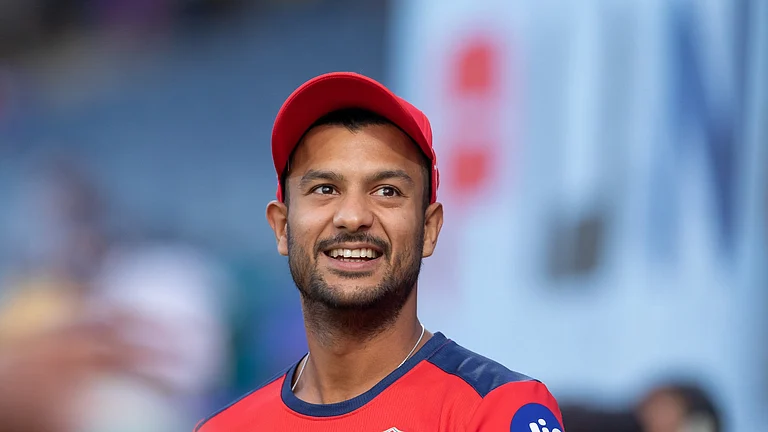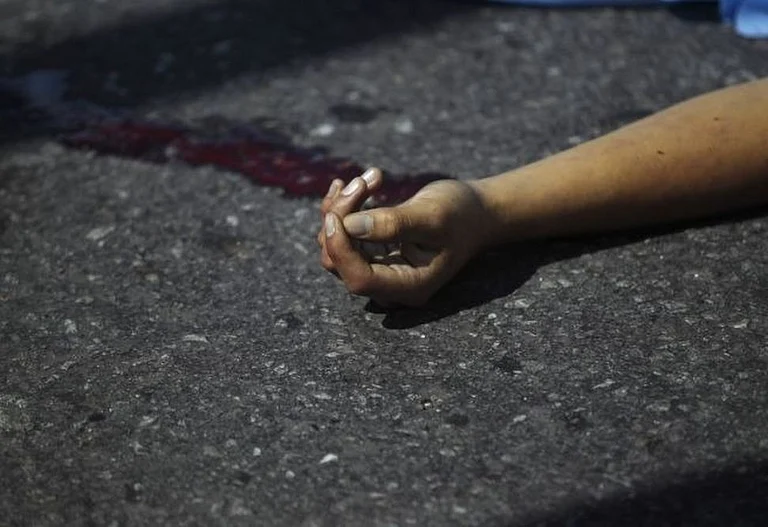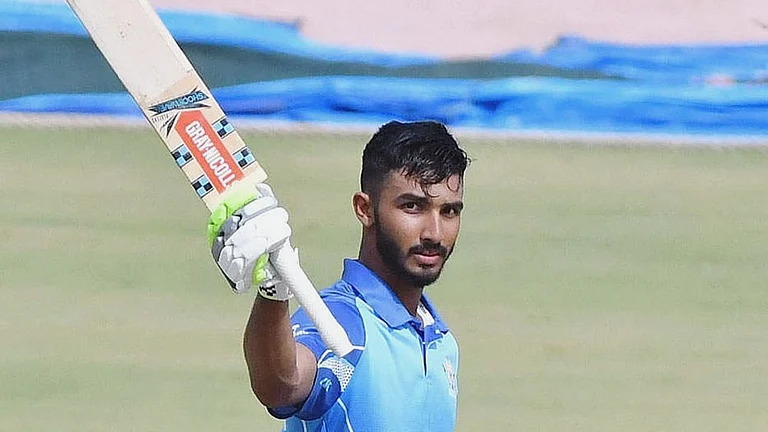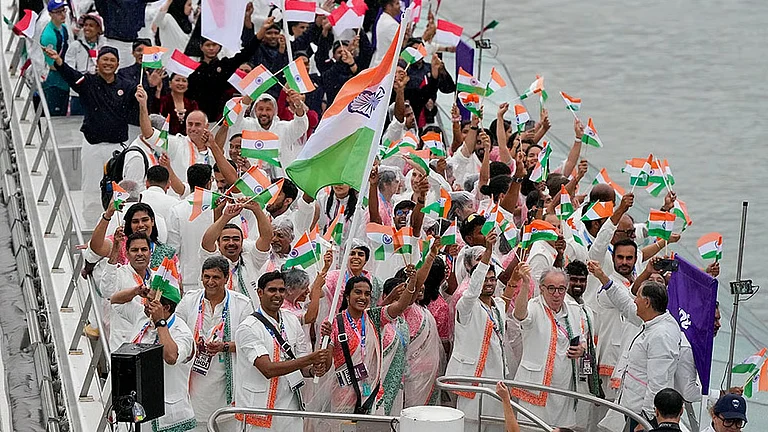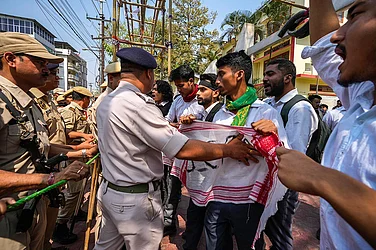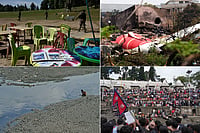As dusk falls over the coastal village of Erwadi in Tamil Nadu’s Ramanathapuram district, the last rays of sunlight cast an amber glow on the green-painted walls and gently sloping tiled roofs of the revered Baba Saeed Ibrahim Dargah. The air is filled with murmurs of prayer, the soft shuffle of bare feet on the sand and a quiet anticipation of healing.
For over 800 years, this shrine on the eastern coast has been more than just a religious site; it has served as a sanctuary for people transcending religious and language barriers. It especially welcomes those struggling with mental illness, emotional trauma or what they perceive as spiritual affliction. However, signboards across the shrine compound announcing in multiple languages that nobody is permitted to be chained serve as reminders of the most devastating disaster related to mental health in India’s history.
On August 6, 2001, a fire that broke out in the early hours at a faith-based mental healthcare centre with a thatched roof adjacent to the shrine killed all 28 mentally ill inmates who had been chained inside. Most were burned alive in their sleep, unable to escape due to the iron chains that bound their legs to the floor or bedposts. People believe a kerosene lamp or a candle had caused the blaze at the privately operated, unlicensed facility. The state authorities intervened by banning chaining, regulating faith-based institutions and introducing medical oversight.
“At several private asylums and religious healing homes that had emerged in the area exploiting the dargah’s legacy, and mostly operating without government oversight or medical personnel, chaining patients was a common practice to restrain violent behaviour or prevent escape,” recalls C. Ramasubramanian, founder of the Madurai-based M.S. Chellamuthu Trust and Research Foundation. “Patients were often kept in inhumane, overcrowded conditions in these institutions that were unaffiliated with the dargah and charged exorbitant amounts.”
In the immediate aftermath of the tragedy, following the intervention of the then district collector, S. Vijayakumar, Ramasubramanian’s organisation began collaborating with the dargah administrators and the local community. They aimed to introduce reforms that promoted scientific and humane treatment, while gradually dismantling abusive systems that masquerade as spiritual healing. The shrine today continues to serve as a poignant reminder of the delicate balance between spirituality and health. Not a substitute for clinical care, it offers something modern medicine often cannot: a sense of belonging, purpose and spiritual meaning.
Every evening the dargah’s sacred grounds come alive as hundreds gather, seeking solace through rituals and prayer, all fuelled by the long-held belief that the dargah has the power to restore sanity. “Nearly 2,000 people from various faiths visit the dargah every day,” says Murasal Ibrahim Alim Vahidi, a trustee of the shrine. One of Tamil Nadu’s most spiritually significant places, renowned for its association with healing, Vahidi claims the shrine was established eight centuries ago to commemorate a Saudi Arabian king named Baba Saeed Ibrahim, who is said to have sailed to India’s southern coast along with his extended family to spread Islam.
Men, women and children from all over south India and beyond, often accompanied by distressed kin, fill the open courtyards and sandy paths between the tombs of Baba’s descendants—weathered structures that serve as milestones on a spiritual journey. Many believe their loved ones are possessed or spiritually troubled. Others are quietly struggling with conditions like schizophrenia, depression or severe anxiety—diagnoses that rarely appear in local conversations but are evident in broken speech or erratic behaviour.
In a land where stigma still surrounds mental illness, Erwadi provides a unique blend of community, faith and hope. Healing is both a collective and personal experience here. Visitors participate in rituals such as reciting duas, sprinkling holy water and spending nights in prayer beside the tombs. Some people stay for weeks or even months, believing their suffering will come to an end through the intercession of the saint. The dargah has come to symbolise more than just spiritual faith; it represents a form of grassroots mental healthcare rooted in cultural beliefs.
As night falls and the stars emerge over the coastline, the chants grow louder. In the shadows, a mother whispers prayers for her restless son. A young man, eyes scanning the darkness, rocks gently beside a tomb. Around them, strangers become companions in their suffering and as seekers of healing. At Erwadi, the path to peace of mind begins not in a hospital ward, but under the open sky—guided by faith, history and a shared desire for relief.
According to Janardhan Babu, programme director at the M.S. Chellamuthu Trust and Research Foundation, it would be untrue if we claimed the dargah promoted illegal healing centres that practised abusive systems and kept mentally challenged people in chains. “The tragic incident revealed similar practices across Tamil Nadu, particularly at the premises of Gunaseelam Temple near Trichy and St Antony’s Catholic Church in Puliyampatti near Jayankondam. Many people turned to black magic and witchcraft to treat mental disorders. There was also a concerning tendency to confine mentally challenged relatives in chained facilities, paying a monthly fee to avoid the responsibility of caring for them,” he says.
Ramasubramanian recalls that the tragedy in Erwadi led the temple administration in Gunaseelam and the Puliyampatti church to adopt scientific reforms. Now, they are all together in combating obscurantism related to mental healthcare. “We convinced the dargah authorities that faith and scientific treatment could coexist. Local leaders were taken to a mosque in Gujarat, where science and faith work together to address mental health challenges. This experience sparked the creation of the iconic Dawa-Dua programme in Erwadi, which initiated a silent revolution,” says Ramasubramanian.
In a significant departure from the past, the dargah complex now features a fully operational mental health clinic that is accessible 24 hours a day. Just outside its walls, a 50-bed hospital operates through a collaboration among the shrine committee, the Tamil Nadu government and the foundation—an important step towards institutionalising compassionate care.
To further enhance mental health services, a 12-bed psychiatric ward is operational at the Government District Headquarters Hospital in Ramanathapuram, providing short-term inpatient care for individuals in acute distress. For those abandoned or left behind by their families, voluntary organisations, including the outreach arm of the foundation, have been enlisted to provide rehabilitation support, helping to reintegrate patients in society through long-term care, counselling and vocational training.
Observers believe these efforts signify a steady transition towards a rights-based, culturally sensitive model of mental healthcare in which healing is pursued not only through prayer, but also through professional support, community involvement and ongoing reform. Today, faith remains a central aspect of the lives of many visitors who come to the dargah in search of relief from mental afflictions. However, the chains that once symbolised suffering are no longer present; instead, some signs and stories reflect a slow but ongoing journey towards dignity and the scientifically restored practice of mental healthcare.
Twenty-four years after the Erwadi tragedy, those involved in mental health restoration remember it as a milestone that revealed the dire state of mental healthcare in the country. The incident led to a renewed focus on scientifically addressing the needs of people with mental illnesses. It also called for reforms at both the national and state levels, aimed at improving the conditions in which mentally ill people, especially those from lower-income families, are treated. As a result, there has been a drastic improvement in mental healthcare across India, and instances of chaining patients have become almost non-existent. Moreover, individuals with acute psychosis are now treated more effectively, which helps prevent the development of chronic conditions.
“Both faith-based healing systems and modern scientific mental healthcare can go together,” says K.R. Pichumani Iyer, hereditary executive trustee of the Sri Prasanna Venkatachalapathy Swamy Temple at Gunaseelam. The temple, with a history of imparting faith-based healing for over 200 years, offers holy water to mentally challenged people who take a dip in the adjoining river Cauvery twice a day for 48 days in a row. Special pujas are held five times a day. “Now, nobody is chained as part of the treatment,” says Iyer. “People stay in the temple premises for treatment, and the temple has ensured around-the-clock access to psychiatrists to address their problems clinically. Those who need hospital admission are shifted with the help of the government and voluntary organisations. The temple committee recently decided to build a full-fledged mental health hospital close to the temple, and the details are now being worked out.”
Iyer also acknowledges that the Erwadi tragedy significantly raised public awareness about mental health issues and the necessity of seeking professional help. Instead of eradicating indigenous healing practices, a more collaborative approach has emerged, particularly in areas with insufficient mental health professionals. Recognising the deep-rooted faith people have in traditional healing, efforts have begun to integrate both traditional and modern approaches to healthcare. Some psychiatrists are now collaborating with faith healers at other religious centres similar to Erwadi and Gunaseelam.
The National Mental Health Survey of 2015-16 reported that nearly 376 faith healers across the country received training in identifying mental health problems. This has led to a significant increase in the number of individuals receiving professional care through referrals. According to Ramasubramanian, who is currently a nodal officer for the Tamil Nadu government responsible for safeguarding the mental health of the state police force, all primary health centres in the state have stocks of basic mental health medicines and periodic consultation visits by psychiatrists.
“The credit for transforming the mental healthcare system in Tamil Nadu largely goes to retired Madras High Court judge, Justice G.M. Akbar Ali, who utilised his tenure following the Erwadi tragedy to streamline corrective actions,” says Ramasubramanian. Besides the judgments related to the subject, Justice Akbar Ali made numerous visits to Erwadi and stood alongside the district collector to hold dialogues with dargah authorities, pushing them to implement reforms.
“I have been spending time around the Erwadi dargah for the past two months to escape my depression,” says K. Ayub Khan, who claims to be a native of Beemapalli near Thiruvananthapuram in Kerala. “This is my second visit since January 2024. I find solace in both the prayers and the medicines available at the Dawa-Dua clinic in the compound.”








